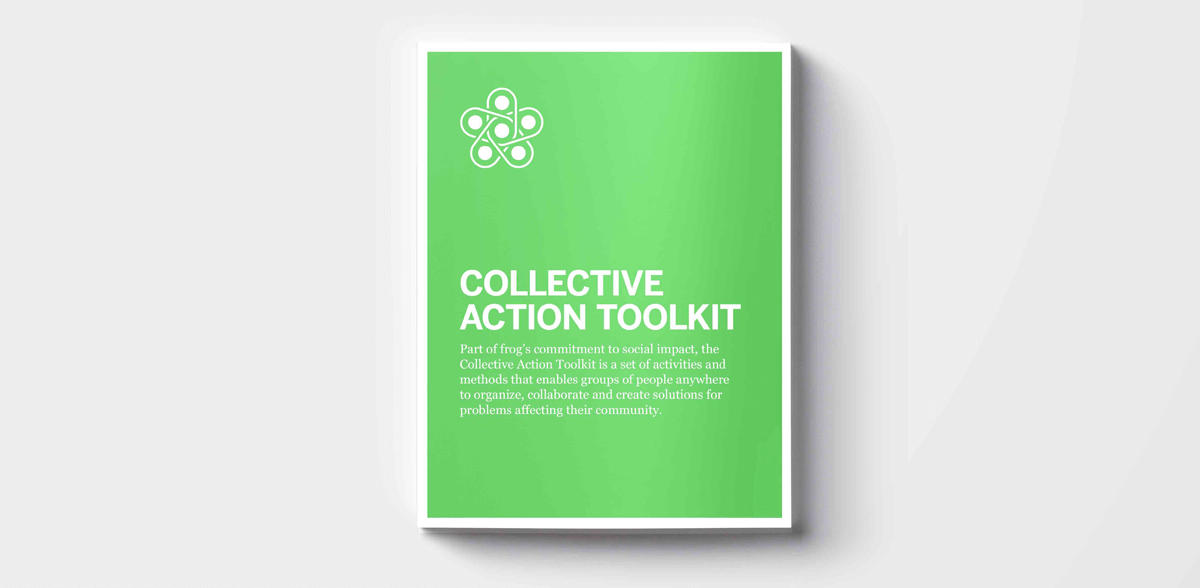
Planning for Action with the Collective Action Toolkit
You’ve brought passionate minds together, aligned on a common focus and generated ideas to achieve your goal. Energy levels are high as the input of raw passion has been shaped into something tangible; something that can and should be realized. But this excitement can quickly devolve into pessimism as you face the daunting task of making it real.
There are reasons companies face paralysis when it comes to closing the gap between innovation and implementation. It can require investments in unproven technology or involve a cultural transformation within the organization. It could demand the development of different channels to reach customers, or it might mandate making money through entirely new means. It requires a massive step change; a departure from the comfort zone of what is known today.
We know it’s hard, and we also know that you’re not alone. More and more, frog finds itself forming frameworks to catalyze these steps for some of the largest organizations on the globe.
The Collective Action Toolkit
So, how do we transfer our ideas on paper (or whiteboards and slides) to the market and into our customers’ lives? The frog Collective Action Toolkit (CAT) applies a pragmatic and measurable lens to achieving this goal with a flexible set of dynamic, group-oriented, non-linear activities that can be used again and again.
If you’re brand new to using the CAT, you can download it here.
Where a first go-round with the CAT is often generative, you can take a second spin through certain activities with an evaluative twist to help you not only plan for, but actively engage in activities like making phone calls, crunching numbers and even testing prototypes.
Now available within the Plan for Action section of the CAT is a new activity called Value Map, demonstrated here. This exercise helps organizations take real action towards their established goals. Drawing from the toolkit, here are steps focused on transitioning from identifying the “why” of your goal to answering the “how.”
First, make it measurable.
Revisit the goal statement that you developed during the Clarify Your Goal section of the toolkit. This should have established the “why,” or your project’s reason for being. These are your roots and everything stems from here. It is likely timeless, like a mission statement, and therefore broad-sweeping. It is also likely that your goal statement is not phrased in a way that you can immediately test progress against it. Let’s attempt to create a second version of the goal – a measurable statement that clarifies the “who,” the “what” and defines the “how”.
We are helping [__who?___] by delivering [___what?___] through/by [___how?____].
For example, frog worked on a project to support farmers who provide the staple food for their respective country (i.e., the “why”). The idea behind this project was to develop mobile products that would help enhance the lives of smallholder farmers.
To make it measurable, we could restate the goal like this:
frog is helping smallholder farmers by delivering critical weather and market information through mobile phones and local ambassadors.
Now we can use our core goal to track success. As in, how specifically are we helping farmers? Is it by delivering weather and market conditions? It is measured through the number of mobile app users and local ambassadors?
Second, develop a Value Map.
The objective of the Value Map exercise is to more granularly map out how you deliver value and what resources you need to do so. A Value Map is not as daunting as it sounds. If you have your goal restated in terms of “who,” “what” and “how,” then you have the necessary pieces to map the value proposition.
Think of your customers’ journey with you and your service:
- awareness (how they know about you)
- decision (how they decide about you)
- engage (how they engage with you and your services)
- re-engage (how they think about you and decide to re-engage)
With your goal in mind, describe what happens between you and the people you are aiming to support at each phase of their journey, then determine how this interaction can be made possible. These are your “channels.”

From here, you can create a cost-benefit model.
- Based on the channels you’ve identified, determine the costs associated with reaching your customer.
- Based on the touchpoints you’ve defined, determine the benefit generated at each touch-point with your customer.

Next, line up the right people.
It’s time to bring this concept to life through a set of partners. Use the Rings of Connection activity in the Build Your Group section of the CAT to help you map the ecosystem of enablers. The objective is to identify and connect with some “doers”: individuals or businesses who can work with you to make your idea a reality. Doers will fall into a few general categories:
- Finance Partners – Who will finance the details in your Value Map? How will you get the funding and support needed to make it happen?
- Social Partners – Who are the people that can spread the good word about your solution? Who are your social partners?
- Subject Matter Expert (SME) Partners – Who are the subject matter experts that you will rely on for critical information and know-how?
- Technology Partners – Who will provide the technology to enable your solution and its channels?
- Cultural Partners – Who will be your local link? Who will translate your ideas and concepts into experiences?
After you identify the people/organizations would be that fills these roles, then connect with them to define terms of working together.

Finally, tie it all together. Launch, measure, revise, repeat.
From both the Value Map and the Rings of Connection activities, you now should have something you can act on. You know what you’re trying to achieve down to the channel level. You also know what the relative cost might be for each channel approach. And finally, you know who you must form partnerships with to make this all work. It’s time to start initiating conversations to build and execute.
This will take time, especially since you’re now relying on more parties and not just yourself and your core team. As such, it’s important to hold your team, your partners, and your service to key measures of success throughout the process. You can use other CAT activities to generate these metrics and to implement continuous learning and feedback loops to ensure you stay true to your goal.
Check back with us to learn how to use the CAT activities to hold our initiatives accountable. As always, if you have any feedback or ideas, we would love to hear from you!


Kara Pecknold is a Vice President of Regenerative Design at frog. For 20+ years, she has been supporting her clients to transform their products, services, teams and business models. She is head of design for frog in Germany and leads a team of designers, strategists and technologists. As a global leader of sustainability, she works at the intersection of people and planet by marrying creativity with science to better shape the future of the Next Economy organization.
We respect your privacy
We use Cookies to improve your experience on our website. They help us to improve site performance, present you relevant advertising and enable you to share content in social media. You may accept all Cookies, or choose to manage them individually. You can change your settings at any time by clicking Cookie Settings available in the footer of every page. For more information related to the Cookies, please visit our Cookie Policy.